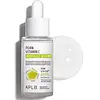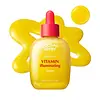What's inside
What's inside
 Key Ingredients
Key Ingredients

 Benefits
Benefits

 Concerns
Concerns

 Ingredients Side-by-side
Ingredients Side-by-side

Centella Asiatica Leaf Water
Skin ConditioningWater
Skin ConditioningButylene Glycol
HumectantPropanediol
Solvent1,2-Hexanediol
Skin ConditioningGlycerin
HumectantDiethoxyethyl Succinate
SolventPanthenol
Skin ConditioningHydroxyacetophenone
AntioxidantSodium Polyacryloyldimethyl Taurate
Emulsion StabilisingAllantoin
Skin ConditioningCellulose Gum
Emulsion StabilisingDisodium EDTA
Citric Acid
BufferingDipotassium Glycyrrhizate
HumectantXanthan Gum
EmulsifyingInulin
Skin ConditioningGlyceryl Acrylate/Acrylic Acid Copolymer
HumectantCellulose
AbsorbentFructose
HumectantGlucose
HumectantAscorbic Acid
AntioxidantDipropylene Glycol
HumectantSqualane
EmollientC12-14 Alketh-12
EmulsifyingAsiaticoside
AntioxidantMadecassic Acid
Skin ConditioningAsiatic Acid
Skin ConditioningSodium Hyaluronate
HumectantMelaleuca Alternifolia Leaf Extract
PerfumingHippophae Rhamnoides Fruit Extract
Skin ConditioningHydrolyzed Collagen
EmollientBeta-Glucan
Skin ConditioningCaprylyl Glycol
EmollientNelumbium Speciosum Flower Extract
Skin ConditioningArtemisia Annua Extract
MaskingOryza Sativa Extract
AbsorbentSaccharomyces Ferment
Skin ConditioningSolanum Melongena Fruit Extract
Skin ConditioningSodium Dna
Skin ConditioningCentella Asiatica Leaf Water, Water, Butylene Glycol, Propanediol, 1,2-Hexanediol, Glycerin, Diethoxyethyl Succinate, Panthenol, Hydroxyacetophenone, Sodium Polyacryloyldimethyl Taurate, Allantoin, Cellulose Gum, Disodium EDTA, Citric Acid, Dipotassium Glycyrrhizate, Xanthan Gum, Inulin, Glyceryl Acrylate/Acrylic Acid Copolymer, Cellulose, Fructose, Glucose, Ascorbic Acid, Dipropylene Glycol, Squalane, C12-14 Alketh-12, Asiaticoside, Madecassic Acid, Asiatic Acid, Sodium Hyaluronate, Melaleuca Alternifolia Leaf Extract, Hippophae Rhamnoides Fruit Extract, Hydrolyzed Collagen, Beta-Glucan, Caprylyl Glycol, Nelumbium Speciosum Flower Extract, Artemisia Annua Extract, Oryza Sativa Extract, Saccharomyces Ferment, Solanum Melongena Fruit Extract, Sodium Dna
Malpighia Glabra Fruit Water
Skin ConditioningWater
Skin ConditioningButylene Glycol
HumectantGlycerin
HumectantCetyl Ethylhexanoate
EmollientNiacinamide
Smoothing1,2-Hexanediol
Skin ConditioningArbutin
AntioxidantHydrogenated Lecithin
EmulsifyingPentaerythrityl Tetrabehenate
EmollientDiethoxyethyl Succinate
SolventBetaine
HumectantCeramide NP
Skin ConditioningHydroxyethyl Urea
HumectantCaprylic/Capric Triglyceride
MaskingMelia Azadirachta Leaf Extract
Skin ConditioningCetearyl Alcohol
EmollientSqualane
EmollientMelia Azadirachta Flower Extract
Skin ConditioningPanthenol
Skin ConditioningCurcuma Longa Root Extract
MaskingTocopherol
AntioxidantCarbomer
Emulsion StabilisingButyrospermum Parkii Butter
Skin ConditioningTromethamine
BufferingXanthan Gum
EmulsifyingAllantoin
Skin ConditioningEthylhexylglycerin
Skin Conditioning2,3-Butanediol
HumectantAdenosine
Skin ConditioningOcimum Sanctum Leaf Extract
Skin ConditioningDisodium EDTA
Sodium Hyaluronate
HumectantSodium Carboxymethyl Beta-Glucan
CleansingCorallina Officinalis Extract
Skin ConditioningMalpighia Glabra Fruit Extract
Skin ConditioningGlyceryl Stearate
EmollientHydrolyzed Hyaluronic Acid
HumectantHydrolyzed Sodium Hyaluronate
Skin ConditioningHyaluronic Acid
HumectantHydroxypropyltrimonium Hyaluronate
Potassium Hyaluronate
Skin ConditioningRubus Fruticosus Fruit Extract
AstringentVaccinium Macrocarpon Fruit Extract
AstringentVaccinium Angustifolium Fruit Extract
Skin ProtectingRubus Idaeus Fruit Extract
AstringentSambucus Nigra Fruit Extract
AstringentCeramide Ns
Skin ConditioningCeramide As
Skin ConditioningCeramide AP
Skin ConditioningCholesterol
EmollientFerulic Acid
AntimicrobialGlutathione
Tranexamic Acid
Astringent3-O-Ethyl Ascorbic Acid
Skin ConditioningPentylene Glycol
Skin ConditioningSodium Hyaluronate Crosspolymer
HumectantSodium Acetylated Hyaluronate
HumectantCeramide EOP
Skin ConditioningMalpighia Glabra Fruit Water, Water, Butylene Glycol, Glycerin, Cetyl Ethylhexanoate, Niacinamide, 1,2-Hexanediol, Arbutin, Hydrogenated Lecithin, Pentaerythrityl Tetrabehenate, Diethoxyethyl Succinate, Betaine, Ceramide NP, Hydroxyethyl Urea, Caprylic/Capric Triglyceride, Melia Azadirachta Leaf Extract, Cetearyl Alcohol, Squalane, Melia Azadirachta Flower Extract, Panthenol, Curcuma Longa Root Extract, Tocopherol, Carbomer, Butyrospermum Parkii Butter, Tromethamine, Xanthan Gum, Allantoin, Ethylhexylglycerin, 2,3-Butanediol, Adenosine, Ocimum Sanctum Leaf Extract, Disodium EDTA, Sodium Hyaluronate, Sodium Carboxymethyl Beta-Glucan, Corallina Officinalis Extract, Malpighia Glabra Fruit Extract, Glyceryl Stearate, Hydrolyzed Hyaluronic Acid, Hydrolyzed Sodium Hyaluronate, Hyaluronic Acid, Hydroxypropyltrimonium Hyaluronate, Potassium Hyaluronate, Rubus Fruticosus Fruit Extract, Vaccinium Macrocarpon Fruit Extract, Vaccinium Angustifolium Fruit Extract, Rubus Idaeus Fruit Extract, Sambucus Nigra Fruit Extract, Ceramide Ns, Ceramide As, Ceramide AP, Cholesterol, Ferulic Acid, Glutathione, Tranexamic Acid, 3-O-Ethyl Ascorbic Acid, Pentylene Glycol, Sodium Hyaluronate Crosspolymer, Sodium Acetylated Hyaluronate, Ceramide EOP
 Reviews
Reviews

Ingredients Explained
These ingredients are found in both products.
Ingredients higher up in an ingredient list are typically present in a larger amount.
1,2-Hexanediol is a synthetic liquid and another multi-functional powerhouse.
It is a:
- Humectant, drawing moisture into the skin
- Emollient, helping to soften skin
- Solvent, dispersing and stabilizing formulas
- Preservative booster, enhancing the antimicrobial activity of other preservatives
Allantoin is a soothing ingredient known for its protective and moisturizingg properties. Because of this, it is often added to products with strong active ingredients.
Studies show higher concentrations of this ingredient can promote wound healing.
Though it can be derived from the comfrey plant, allantoin is produced synthetically for cosmetic products to ensure purity.
Learn more about AllantoinButylene Glycol (or BG) is used within cosmetic products for a few different reasons:
Overall, Butylene Glycol is a safe and well-rounded ingredient that works well with other ingredients.
Though this ingredient works well with most skin types, some people with sensitive skin may experience a reaction such as allergic rashes, closed comedones, or itchiness.
Learn more about Butylene GlycolWe don't have a description for Diethoxyethyl Succinate yet.
Disodium EDTA plays a role in making products more stable by aiding other preservatives.
It is a chelating agent, meaning it neutralizes metal ions that may be found in a product.
Disodium EDTA is a salt of edetic acid and is found to be safe in cosmetic ingredients.
Learn more about Disodium EDTAGlycerin is already naturally found in your skin. It helps moisturize and protect your skin.
A study from 2016 found glycerin to be more effective as a humectant than AHAs and hyaluronic acid.
As a humectant, it helps the skin stay hydrated by pulling moisture to your skin. The low molecular weight of glycerin allows it to pull moisture into the deeper layers of your skin.
Hydrated skin improves your skin barrier; Your skin barrier helps protect against irritants and bacteria.
Glycerin has also been found to have antimicrobial and antiviral properties. Due to these properties, glycerin is often used in wound and burn treatments.
In cosmetics, glycerin is usually derived from plants such as soybean or palm. However, it can also be sourced from animals, such as tallow or animal fat.
This ingredient is organic, colorless, odorless, and non-toxic.
Glycerin is the name for this ingredient in American English. British English uses Glycerol/Glycerine.
Learn more about GlycerinPanthenol is a common ingredient that helps hydrate and soothe the skin. It is found naturally in our skin and hair.
There are two forms of panthenol: D and L.
D-panthenol is also known as dexpanthenol. Most cosmetics use dexpanthenol or a mixture of D and L-panthenol.
Panthenol is famous due to its ability to go deeper into the skin's layers. Using this ingredient has numerous pros (and no cons):
Like hyaluronic acid, panthenol is a humectant. Humectants are able to bind and hold large amounts of water to keep skin hydrated.
This ingredient works well for wound healing. It works by increasing tissue in the wound and helps close open wounds.
Once oxidized, panthenol converts to pantothenic acid. Panthothenic acid is found in all living cells.
This ingredient is also referred to as pro-vitamin B5.
Learn more about PanthenolSodium Hyaluronate is hyaluronic acid's salt form. It is commonly derived from the sodium salt of hyaluronic acid.
Like hyaluronic acid, it is great at holding water and acts as a humectant. This makes it a great skin hydrating ingredient.
Sodium Hyaluronate is naturally occurring in our bodies and is mostly found in eye fluid and joints.
These are some other common types of Hyaluronic Acid:
Learn more about Sodium HyaluronateSqualane is an emollient that helps the skin hold onto moisture. It's an oily liquid that occurs naturally in certain types of fish and plant oils.
Because squalane boosts hydration in the skin, it also comes with plenty of benefits: it is an antioxidant and can help fight free radicals and skin damage. Squalane is also found to have a detoxifying effect when applied.
Squalane comes from squalene, which occurs naturally within the sebum of our skin. It is one of the oils our skin produces to keep itself hydrated. Squalane is the hydrogenated version of squalene and has a longer shelf life.
Research shows that squalane is non-irritating (even at 100% concentration).
In general, it's a fantastic ingredient. It does a great job at hydrating the skin, and it's suitable for those with sensitive skin.
The source of squalane may impact malassezia / fungal acne. This is because olive oil derived squalane can contain impurities such as fatty acids and plant waxes. Sugarcane derived squalane is recommended for anyone with malassezia concerns.
Is squalane vegan?
This depends on the source. Squalane can be derived from both plants and animals. Most squalane used in skincare comes from plants.
Please note: the source of squalane is only known if disclosed by the brand. We recommend reaching out to the brand if you have any questions about their squalane.
Read more about squalene with an "e".
Is squalane an oil?
Squalane is often called an oil, but it’s technically not; it’s a hydrocarbon, meaning it’s only made of carbon and hydrogen, unlike true oils which are triglycerides made of fatty acids and glycerol.
The term “oil-free” isn’t regulated, so companies can define it however they want. Some exclude all oils, while others just avoid mineral oil or comedogenic oils.
While some people avoid oils thinking they cause breakouts, the right kind of oil (or oil-like ingredient like squalane) can actually help balance and hydrate your skin. It’s worth testing out simple oils or squalane to see what works best for your skin.
Learn more about SqualaneWater. It's the most common cosmetic ingredient of all. You'll usually see it at the top of ingredient lists, meaning that it makes up the largest part of the product.
So why is it so popular? Water most often acts as a solvent - this means that it helps dissolve other ingredients into the formulation.
You'll also recognize water as that liquid we all need to stay alive. If you see this, drink a glass of water. Stay hydrated!
Learn more about WaterXanthan gum is used as a stabilizer and thickener within cosmetic products. It helps give products a sticky, thick feeling - preventing them from being too runny.
On the technical side of things, xanthan gum is a polysaccharide - a combination consisting of multiple sugar molecules bonded together.
Xanthan gum is a pretty common and great ingredient. It is a natural, non-toxic, non-irritating ingredient that is also commonly used in food products.
Learn more about Xanthan Gum